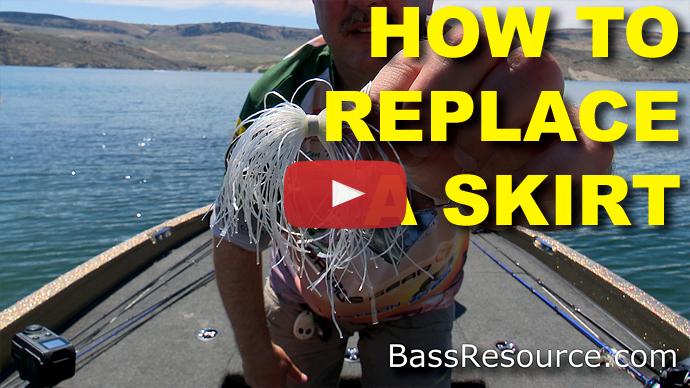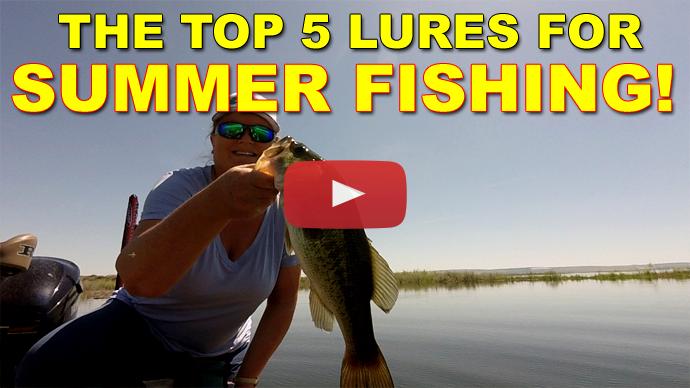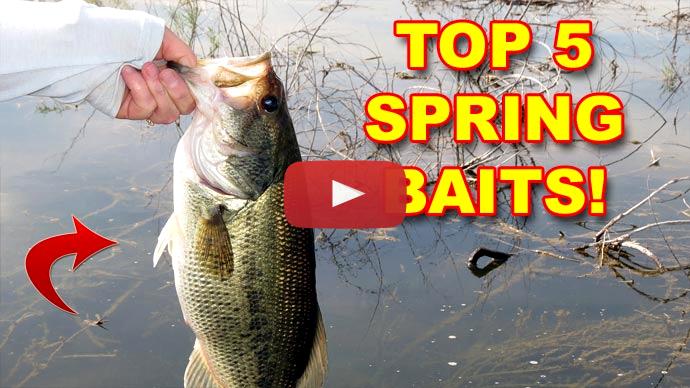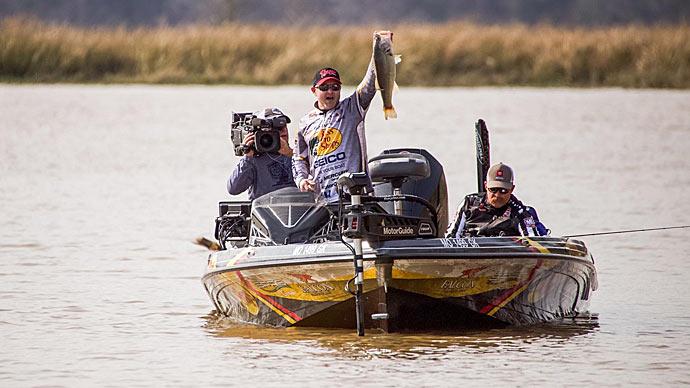Glenn May: There we go. There we go. Okay, come on in. He's got a little belly on him. He'd been eating. That'll work. Nice bright bluebird day. Why not throw a Buzzbait? Look at that clear water.
Hey, folks. Glenn May here with BassResource.com and today I wanna talk to you about fishing Buzzbaits. Yeah, Buzzbait's great lures to use. When fish are biting, they're aggressive. Topwater is an exhilarating bite. It absolutely is. It's so much fun. This one here, this is what I'm talking about, Buzzbait. That's what they look like.
Now, this skirt, you guys made…you want to know what that skirt is. It's a Lumaflex Skirt. They're hard to find, but I like using these skirts on it. I do a lot of modifications on these baits. I'll show you what that's all about here in a minute. But I'm gonna give you a brain dump here, all the stuff I know about Buzzbaits. I've been fishing for about three or four decades now. And there's more to them than just chucking and winding.
So, let's start off, first of all, with the gear. You've got to have the right gear when you're fishing Buzzbaits. So this here's a seven-foot four, medium-heavy power, moderate action rod. That's what I like for throwing these. And moderate is...the reason being is because Buzzbaits are relatively light. They're kind of hard to throw. So moderate action allows you to fling that bait out there. Plus it's got the backbone to set the hook. These have big heavy hooks on them, thick hooks. And it's hard to set the hook if you got a wimpy rod. So medium-heavy rod with a moderate action tip is exactly what you want.
Paired with that is a fast action reel. Fast speed, you need that to get it up on plane and retrieve it. And then with the line I'm using...today, this here line is monofilament. I like monofilament a lot because it floats. It helps get the bait up on plane. But if I'm throwing to a lot of heavy, heavy cover, what I'll do is I'll change up the braid and I'll use Seaguar, at least 40-pound braid. Maybe 30-pound or 50-pound braid depending on what I'm throwing. I like the 50-pound when you're fishing heavier cover. It's buoyant so it aids in getting the bait up on plane and keeping it up on the surface better. If you're fishing a lighter lure then I might go down to 25 or 30-pound braid.
So that's what I use for throwing it. Let's talk a little bit about the baits themselves. The most popular ones are the 3/8 ounce. Sometimes quarter ounce. This is a 3/8 ounce. That's what I fish the most, for most conditions. If I'm fishing, say, in the springtime, right after the spawn I'll go a little bit smaller. I'll use a quarter ounce to match the baitfish and then as summer progresses, I'll go back up to that 3/8 ounce bait. I might even use an eighth ounce just right after the spawn, real light, light bait.
In windy conditions, yeah, it's harder to cast. It's harder to control the bait. It's harder to get it...the accuracy. So then I'll go up to a half ounce bait at that time. That way you can get it out through the wind. The wind won't catch it and throw it somewhere where you're not aiming. Half ounce works really well for that, but for the most part I'm throwing quarter ounce, 3/8 ounce Buzzbaits. There we go, finally.
Woman: Buzzbait. You're gonna make me throw a Buzzbait, aren't you? He is gonna make me throw a Buzzbait.
Glenn May: I am.
Keri: Hey, look at that. Finally. Look at that.
Glenn May: Look at that, 2:30 in the afternoon on a bright sunny day.
Keri: Yup.
Glenn May: Can't beat that. Don't ever let them fool you into thinking that you can only do it in the early morning hours or in the evening. Proof positive.
Now there's several different designs of Buzzbaits out there. This is that single blade. Look how big that blade is. It's a big blade. That enables it to come across the water at a slower speed. A bigger blade allows you to get it up on plane and kind of go as slow as you can across the water. And a lot of times, that's the best way to fish a Buzzbait, is a slow...slow across the water as you can. But in other times, the fish really want you to move it quick, and then I'll get a smaller sized blade. But a lot of the blades come in different colors. You've got gold. You've got silver. You have a lot of different...there's actually about every color in the rainbow really. There's a lot of different ones you can get. But I just stick with silver or gold, but there's a couple of other designs too to look at.
For example, there's the double buzzer blade, right? Pretty wacky looking. This gets up on plane easier and you can fish it real slow because it's got both blades to keep it on plane. For me, I don't catch as many fish with a double blade Buzzbait, but when I do catch one it's usually big. So this is a really good bait to throw, say, for example, you've got a limit on a tournament and you want to start culling out and get bigger fish. That's when I would start throwing something like this. Or if you just want to target big bass, good bait to throw.
Another type...some of these, they come with double buzzers inline, triple sometimes. This will be a triple version. There's a lot out there, but I tend to stick to those and in this kind, too.
This is a clacker, all right. It's got a clacker on it. What that does, the blade hits it. So I don't know if you can hear it or not but it goes across the water and it makes a lot of ruckus, a lot of noise. It can attract bass from further distance away. This is a great bait to use in the middle of summer when bass are super aggressive. You're throwing across big flats of submerged weeds and vegetation where you need to call them from long distances or dig 'em out of the cover. Something like this with a clacker, it works really well.
This is a white chartreuse skirt. White skirt and a black skirt. Those are basically the three you need. You really don't need to get too crazy on these. I think the bass is really going after the commotion that this blade is causing more than the color. But even so, when I'm fishing at night, I'll use black so I got a good solid silhouette going across the surface. When the fish is looking up, they see a solid silhouette, so I'll use a black skirt then. Otherwise, I'm using white most the time.
But where to throw it? Best place to throw and best times to throw it. I'll usually fish it...anytime the water temperature is above 55 degrees, that's a good time to throw it. I know it works when it's colder out. I have one stuck in my brain for sure.
I was fishing New Year's Eve, water temp was 42 degrees and I saw what appeared to be bass busting baitfish on the surface, which is crazy. They don't do that during the wintertime. Don't they read the same books we do? They weren't supposed to be there. But I tied on a Buzzbait and went out there and threw, and sure enough, boom, I caught a fish on a Buzzbait on New Year's Day. So they can work. I'm not saying there's absolutes. But when the water temp's above 55 degrees, that's when you get more bites on a Buzzbait.
And I like to fish it over submerged weed beds. That's my favorite place. There's milfoil, hydrilla where it hasn't broke the surface, or maybe stump fields or sparse lily pads. That's great place to throw a Buzzbait. You can throw it out over it. Call fish from long distances. If you got these vast flats with all this on here, you can just start casting the 10 o'clock, the 11 o'clock, 12 o'clock, 1, just methodically fish your way as you go down over a flat. You just keep making those casts like that and you're gonna catch a lot of fish just by being that methodical.
As far as the retrieve is concerned, it's pretty straightforward. Cast out, bring it back, right? Okay, there's a little more to it than that. Two things. First of all, you've got to get the blade moving first. And that is the main trick in the retrieve. A lot of times that you do it with a bait, you cast it out there, it hits the water. And then you turn the reel handle and start retrieving. I like to throw...the best way to throw a Buzzbait is when you throw it out there, you actually turn the reel handle just as it hits the surface or before it hits the surface. And turn it really quick, this is where you need that fast gear ratio, to get that blade moving and get it up on the surface. Once it's moving, then you can slow down the best you can. Keep that rod tip up about the 10 o'clock position to keep that bait up on the surface and slow down as much as you can while keeping that blade above the surface and bring it on back.
That is the normal retrieve that you catch a lot of bass on. It's that cast. It's the reason why I like using baitcasting gear. You can thumb that reel and get it almost to stop. You can put your thumb on the reel as you transfer hands midair and turn...get the reel handle going right when it hits the water. It's very, very difficult to accomplish that with the spinning gear. You can try but a lot times what happens is you get a loop in the line, and you're next cast, you're gonna get big bird's nest. So it's very difficult to cast this way with spinning. This is why I like using baitcasting gear.
Other retrieves, if you're not going after with a nice, slow, steady retrieve, speed it up. That's the first thing I would do. Try different...various speeds. I like to fish slow because the fish, it gives them time to find the bait. It gets them...it stays longer in the strike zone and they're more apt to get it when they blow up on it. If you're reeling it really fast, you have a lot more missed strikes. But sometimes that's the way the fish want is a fast retrieve.
Another thing is when you're just retrieving it, give it a little pop. Give it a little jerk. Just give it a little erratic movement and sometimes that elicits the strike. The fish will be following, following, and following. You give a little pop, boom, they'll just clock it all of a sudden.
Keri: Whoa. He missed.
Glenn May: There he goes. No, we got it. He came back.
Keri: He came all the way out of the water.
Glenn May: He came back and hit it twice.
Keri: He came all the way out of the water for that. That was awesome.
Glenn May: He missed it, turned around and hit it again.
Keri: Hit it again. Nice-looking Buzzbait fish. All day long. Face full of Buzzbait. Come here, baby. Oh boy, let me see if I can get you out but I don't know how I got you hooked. I'm trying, kiddo. Nice little guy. He came all the way out of the water. Holy smokes. That just shocked me. Okay, little guy, go have fun. Evidently, I got the fin.
Glenn May: There's a lot of different modifications people do. One of them is this. You bend it...you literally...see, the wire is bent. You literally bend the wire to one side and you can curve it. And you can get it up underneath docks, for example, instead of alongside the docks. It's a great way to get up underneath things, overhanging trees. Sometimes these baits, when you cast them, they're coming back like that on their side, one side or the other. Then you wanna take the blade part and twist it one side or the other. Not the arm, but the blade. And that's…just like tuning a spinnerbait, if you've ever done that. Move that blade one way or the other. Tune it so it'll run straight.
A couple other modifications people like to do, I know some people like to put them, hang them by their antennas on their car when they're driving down the freeway so they get it to squeak. Make a lot more noise. Some people like to put the rivet into some kind of acid of some sort to make them squeal, make more noise. You can do that. I don't go to that extent, but some people like that.
But putting trailers on the bait, that's one thing I will do. So, for example, I like to use the YUM Pulse Minnow. I'll take a 3 1/2 inch Yum Pulse Minnow like this. I'll take the skirt off and put this on. It gives an entirely different profile, and a lot of times you get a lot more strikes that way. Just making...they don't like the skirt, but they want something like this and it looks realistic to them. I'll use a 3 1/2 inch from spring to midsummer, and then from midsummer through fall I'll up it and go to the 4 1/2 inch to match the growth of the baitfish.
Another trailer that I'll put on here is the YUM...the Tip Toad, here it is. This color, by the way, is pearl white. That's the color I use most of time when I'm doing it with the Tip Toad. I like the summer gill and also watermelon with red flake. But the summer gill works really well.
This Tip Toad, you put that on instead of the skirt and that does a couple things. Number one, it has more buoyancy. It's easier for to get it up on plane and float on the water and stay on the water. It's got these little kickers in the back so it creates even more of a commotion. And you can bring it back a lot slower because of the buoyancy. It's a great modification to make. It gives it a bigger profile, plus it adds weight to the bait. So now you can throw it further distances. Be more accurate with it. You can throw it in the wind better. Great modification to make to these baits.
Keri: There you go. Fish on a Chatterbait. Sorry.
Glenn May: Buzzbait.
Keri: Buzzbait. Buzzbait fish.
Glenn May: Come here.
Keri: Buzzbait. Oh, that's a nice one, too. A really nice one.
Glenn May: You notice the sun's out?
Keri: Yeah.
Glenn May: No clouds.
Keri: Bright sky, no wind.
Glenn May: Don't stop fishing these just because the sun came out. Boy, I got him right in the roof of the mouth.
Keri: Right where you're supposed to catch it.
Glenn May: There we go. All right.
Keri: Nice little guy.
Glenn May: Let you go.
The last thing I want to talk to you about is the hookup. A lot of people, they have problems with hookup ratio. Bass will come up. They'll miss it. It happens a lot. They miss it. You set the hook, there's no fish. A lot of times what people do is they take a trailer hook and they add it to their Buzzbait. A trailer hook basically is just this. That's just this little thing. I'll show you how it looks like. It's got a little rubber...it's got a little piece of surgical rubber on it. And you got a little trailer hook right here on the end. It's this little stinger that you add at the end of it. And this little rubber piece here keeps it from going past the barb that stays on the hook, okay?
A lot of people like to put a trailer hook on there to get those fish that blast at it and miss it. I don't. That's the only Buzzbait I have with a trailer hook on it. I don't like to use them because, typically, you're fishing it over weeds or vegetation then you get hung up more often with that trailer hook. Instead, you really need to focus on your hookset when the fish hits the lure.
So what I mean by that is a lot of times the fish will come up, it'll blast the lure and what you see is this explosion and. If you're not ready for it, there's that knee-jerk reaction. Just, boom, set the hook right away. And that's when you pull the bait away from the fish. And how that happens, the fish blows up through the water, his mouth is open. Your lure is here, he doesn't have it yet. You react to that explosion, you pull it away from him and he misses it. It's kind of like Lucy taking the ball away from Charlie Brown, right?
What you need to do is while you're retrieving this bait, be ready for that explosion. Keep telling yourself, "Don't set the hook. Don't set the hook. Don't set the hook. Wait for it. As soon as that hits, don't set. Don't react." Whatever it is, coach yourself on that. So when it happens, you go...I mean, even I flinch because I'm not ready for it even though I'm still telling myself, but you won't react and set that hook right away.
What you need to do is wait until that fish turns, swims underwater and you feel him swimming away with your lure. When you feel that, boom. Then you pop him. And then you set the hook. But you have to have that discipline in order to do that. If you do that, you'll have more hookups and you'll catch a lot more fish.
So those are the tips I have for fishing Buzzbaits. I hope it works for you. For more tips and tricks like this, visit BassResource.com.





